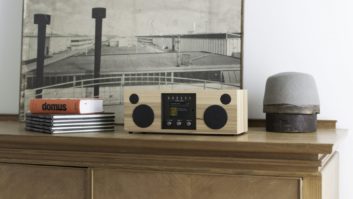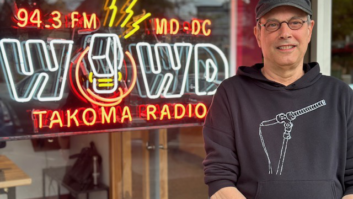WASHINGTON � The process for registering for the Federal Communications Commission�s new EAS Test Reporting System has hit its share of bumps and potholes, according to broadcasters who have logged into it.�

�
We�told you earlier�about some of the headaches. Problems reported to Radio World include the length of time required to use the system as well as concerns over coordinates and database organization. All stations are required to log into this new system and complete the initial ETRS form, known as Form One, by Aug. 26. Contacted by Radio World, a spokesman for the FCC said the commission�s staff was aware of frustrations and had taken steps to address some of the issues (see sidebar story below).
�
Registrants have expressed frustration with some of the specifics required during the process. Form One asks the user to identify the version of its EAS software. This may prove tricky for devices purchased from manufacturers like TFT, which went out of business in 2015.�
�
�How could a TFT purchased in 2006, for example, and never updated, comply with regulations such as CAP that did not exist then?� asks John O. Broomall with Christian Community Broadcasters, which has been working with several low-power stations on their ETRS registration forms. �How can small stations, often with used TFT units or relatively new GMs, know which version software they have and if it is compliant with the latest requirements?�
�
There have also been questions raised about the length of time it will take to complete the registration process. As Radio World reported, the official �annual reporting burden,� as�stated in the Federal Register,is 43 hours.
�
The commission confirmed that figure but an FCC spokesperson said the filing process should take significantly less time; the higher figure covers initial registration as well as post-test filing. For example, the spokesperson said, in recent days it took filers an average of three hours to complete an initial filing.�
�
But some in the trenches are not pleased. �Is it really going to take up to 43 hours to do this, and for two stations will that be up to 86 hours?� asked Cal Zethmayr, general sales manager of WAAZ(FM) and WJSB(AM). �We are a small-market station with three full-time and two part-timers. I�ve been in radio 62 years and done thousands of FCC pieces of paper over those years. This is the absolute most ridiculous thing yet. We cannot afford to devote two work weeks for any one employee to this.� To expedite the registration process, the FCC is recommending that filers have information at hand about their station and their governing state EAS plan when completing the online form. ETRS registrants also expressed confusion over specific location data that registrants are required to enter. A section requires users to enter transmitter coordinates, at which time users encounter a coordinate converter that has been described with words like ridiculous and confusing.
Transmitter coordinates are traditionally entered as�NAD 27�degree, minutes, seconds. �But for some bizarre reason you must change to NAD 83 decimal coordinates,� said Broomall. �Ridiculous.�Said Zethmayr: �I note that [the] form asks for NAD83, yet the FCC database shows NAD27 for all stations.�
�
A tool on the public FCC site permits a user to convert latitude and longitude between decimal degrees and degrees, minutes and seconds. (A link is included to the National Geodetic Survey�s NADCON program, which allows conversions between the NAD83 / WGS84 coordinate system and the older NAD27 coordinate system.) NAD27 coordinates are used for broadcast authorizations and applications, the FCC said. Broadcaster Tom Taggart with Seven Ranges Radio completed Form One for an LPFM and it auto-populated the transmitter coordinates, which was welcome, he said. �The NAD 27 to 83 converter was giving me error messages and no results,� he said.�
�
Radio World Technical Advisor Tom McGinley said the coordinates issue �stumps a lot of folks at first, but then when they understand the constraints and requirements to be able to enter acceptable and valid data � including the NAD 27 to 83 conversion � it�s not so bad.�Others expressed frustration with the way the commission organized the database in regard to a facility�s registration number, or FRN, as opposed to the standard station identifier.�
�
�I do not like the way the FCC has things set up per FRN entity as opposed to per station,� said Cris Alexander, director of engineering at Crawford Broadcasting Co. and a Radio World contributor. �How much better it would have been if it were set up by station entity using FIDs.�
�
Due to the way the system is set up, Alexander said he can�t distribute log-in credentials to his local engineers for license entities; once someone logs into that entity, it brings up access to all the stations for that entity, and many of those stations will not be part of the same local market.�To make matters worse, he said, call signs are not listed on the �records� tab where Form Two and Form Three are submitted, so it would be a relatively easy error for someone to submit a report for the wrong station or even the wrong market, especially if they were in a hurry.� �Because of this, for my company � and likely many others as well � reporting will have to be centrally done,� Alexander said.
�
Others said that while the database did auto-populate a few items correctly, there were frustrations over entering a station�s operational area. Zethmayr, for one, noted that his station is in Florida Operational Area 1. �But [the database] will not accept that. Instead it wanted West Florida Panhandle, which is not how our three-county area is listed in the 2016 Florida Plan.�
�
FCC Acknowledges Concerns, Offers Suggestions
�
The commission acknowledged that some registrants have encountered problems during the ETRS registration process.
In response, the commission has created a FAQ for single-facility filers and is focusing on problems facing batch filers. According to an FCC spokesperson, the commission has also taken a number of other steps to help EAS participants use the new system including:
- Posting a user�s manual in the ETRS system.
- Setting up a dedicated email box for questions, which the commission is attempting to answer within 24 hours ([email protected]).
- Conducting webinars to familiarize EAS participants with the ETRS and to answer their questions.�
Those looking for information about or assistance with ETRS can contact the FCC at�[email protected], or via Austin Randazzo, attorney advisor in the Policy and Licensing Division at 202-418-1462 or�[email protected].
�
After attempting to add a geographic zone, Zethmayr attempted to enter Operational Area 1 only to find the database restricting his entry to Operational Area 10 or 11. �I tried Florida Operational Area 1, and it will not accept it,� he said. �So far one hour of the 43 has been wasted.�
�
FCC spokesperson, EAS participants have successfully completed more than 2,700 filings.
�
Most of the concerns the FCC has heard have centered around who exactly is required to register and file, what approach EAS participants should take to register and file efficiently, and how EAS participants can confirm the accuracy of their submissions.�
In response, the commission has taken several steps, including creating a FAQ for single-facility filers in response to their feedback, and has begun focusing on addressing the process and issues concerning those that file on behalf of multiple EAS participants, otherwise known as batch filers.
�
Broadcasters can log into the�FCC�s new ETRS�here.�
�
A version of this article originally appeared on the website of Radio magazine sister publication Radio World.�
�












